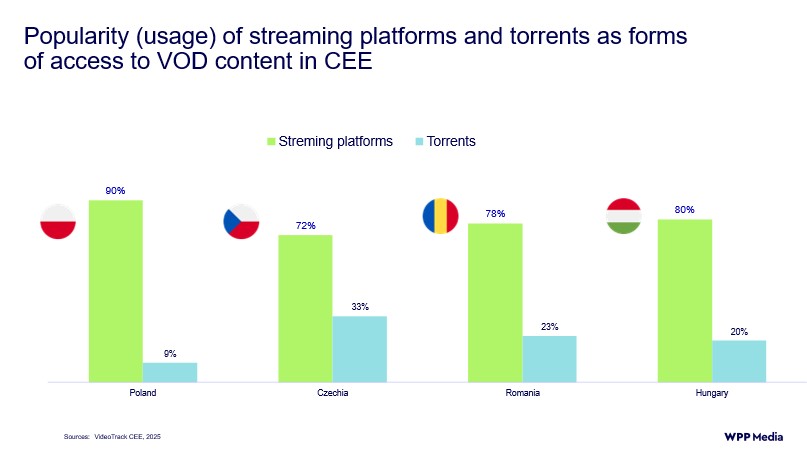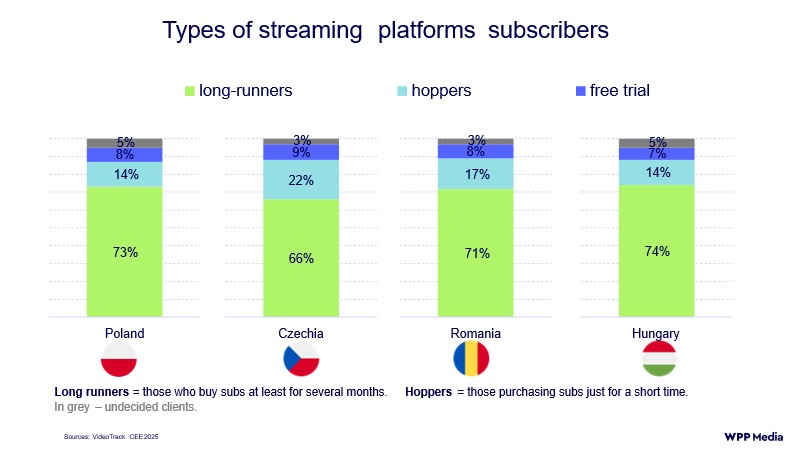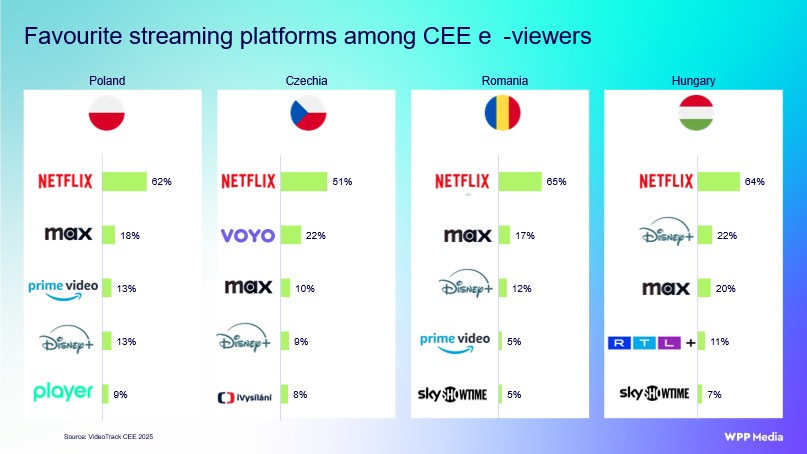According to the latest study by VideoTrack CEE from WPP Media, the streaming market in Central and Eastern Europe is a dynamic environment where global trends mix with local specifics. Netflix remains the dominant brand, but each country has its own specifics, and the Czech Republic differs from the others in some respects.
The study shows that streaming services are used by the majority of online users in the Central and Eastern European countries surveyed (Poland, Czech Republic, Hungary, Romania). The highest usage is in Poland (90%) and Hungary (80%). In the Czech Republic, the figure is 72%. At the same time, the Czech market has the highest proportion of so-called "streaming jumpers," i.e., viewers who frequently change their subscriptions between different platforms or use them for a short time. This is also reflected in the fact that the Czech Republic has the lowest proportion of "long-term" subscribers among the countries surveyed.
Up to a third of Czech online viewers (33%) still download movies and series from the internet, while in Poland, for example, the figure is only 9%. This higher rate of piracy correlates with the lower willingness of Czechs to pay for video content, with the Czech Republic having the lowest share of paying SVOD users in the entire region.
 Percentage of users using streaming services and downloading video content from the internet; Source: WPP Media
Percentage of users using streaming services and downloading video content from the internet; Source: WPP Media Types of subscribers to streaming platforms; Source: WPP Media
Types of subscribers to streaming platforms; Source: WPP MediaLinear television is declining in the region. Over the past five years, viewership among all viewers (4+) has decreased: by 12–14% in the Czech Republic, Poland, and Romania, and by 6% in Hungary. The decline is even more pronounced among young people aged 15–24, with linear TV viewership falling by half in ten years.
However, there is no mass disconnection from pay TV in Central and Eastern Europe. The share of households with pay TV remains high. In Romania and Hungary, it is 90%, and in Poland 75%. In addition, a model of cooperation between operators and streaming services is developing in some countries: in Romania, for example, up to 37% of SVOD customers purchase their subscription through an operator. This purchasing model is particularly popular among the so-called silver generation, i.e. people over 55. For them, pay TV is often a gateway to the world of streaming. Telecommunications companies also play an important role in subscription distribution in all markets surveyed.
The importance of smart TVs is growing rapidly in all markets. The share of active users of smart TVs who watch streaming apps directly on their TV screens ranges from 52% in the Czech Republic to 61% in Romania among online viewers in Central and Eastern Europe. The TV screen is no longer just the most commonly used device for watching movies and series online, but has also become the most popular device across all age groups. Netflix and YouTube dominate the rankings of the most popular Smart TV apps.
Netflix is the most popular streaming platform in the countries surveyed. However, the local service Voyo (now Oneplay) is also gaining ground in the Czech Republic, where it is the second most popular. HBO Max and Disney+ also rank among the most popular overall. Prime Video is a popular service in Poland.
 Most popular streaming platforms; Source: WPP Media
Most popular streaming platforms; Source: WPP MediaAbout the VideoTrack CEE study
The VideoTrack research was conducted by WPP Media in March, May, and June 2024 in Poland, the Czech Republic, Hungary, and Romania, on a sample of 6,000 internet users who watch video content. VideoTrack CEE is a regional edition of streaming service research that Wavemaker and WPP Media (formerly GroupM) have been conducting in Poland for almost ten years. WPP Media examines internet audiences, i.e., people who watch movies, series, and other long-form (professional) video content online.
Source: mediaguru.cz

